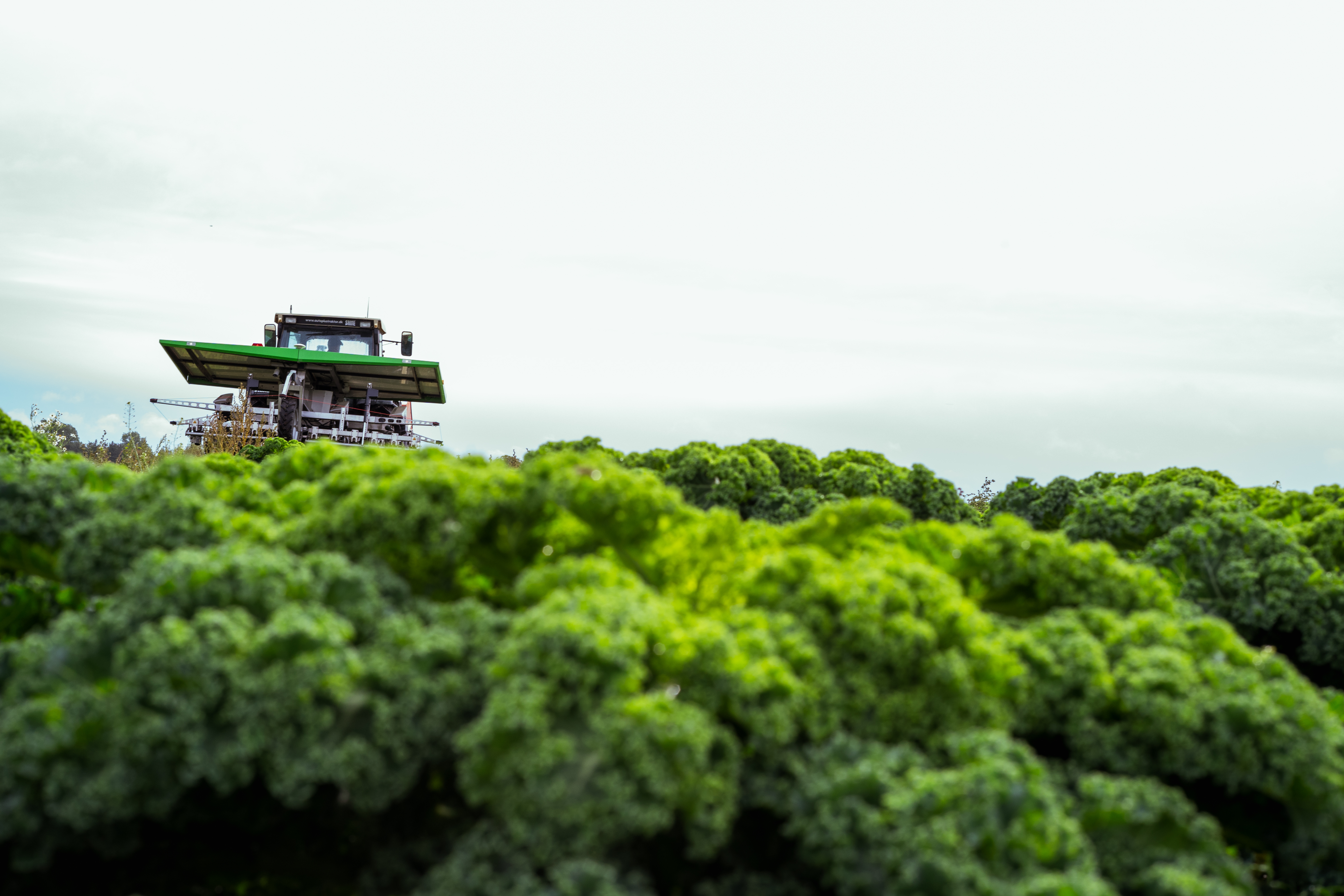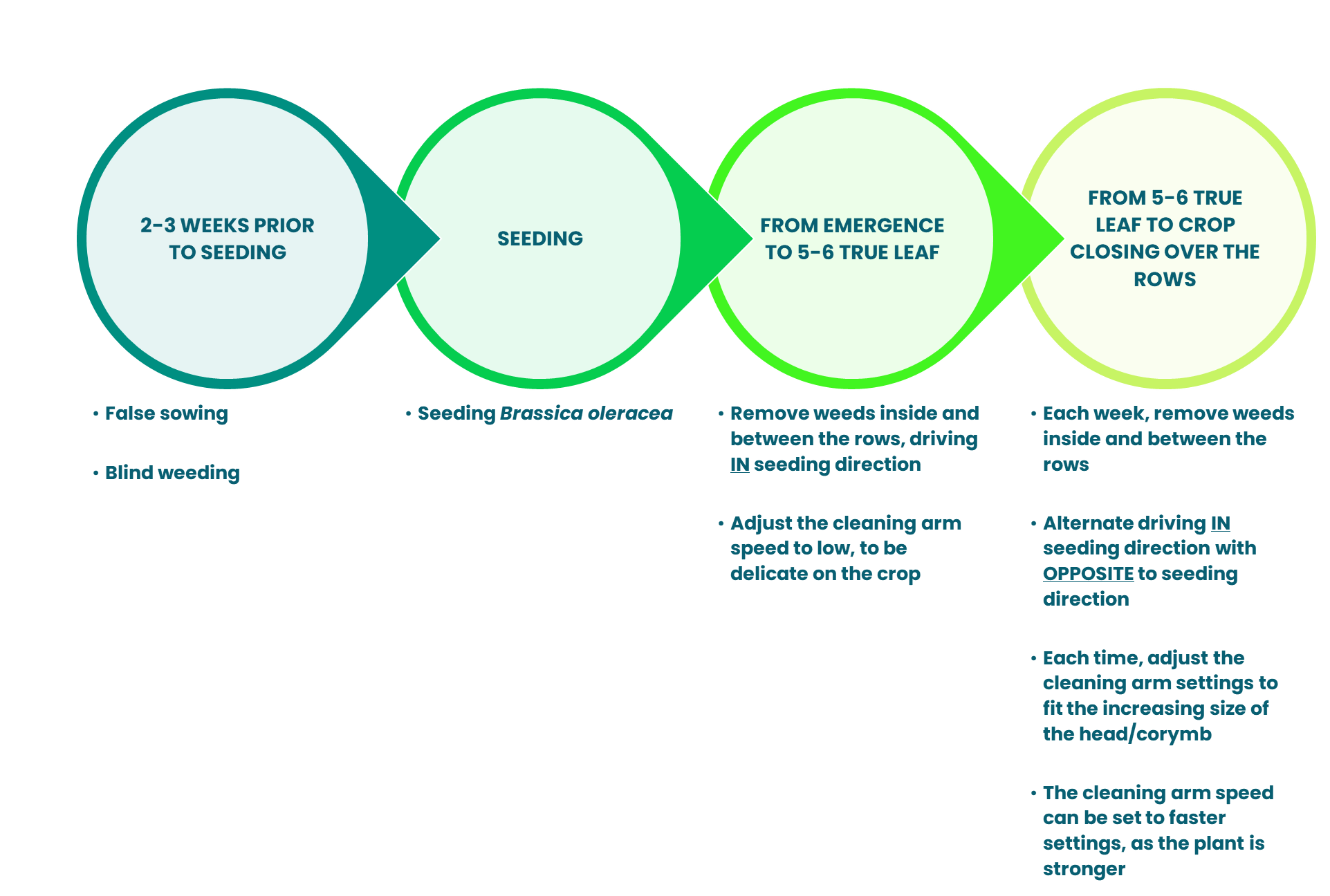KALE, CABBAGE, BROCCOLI, CAULIFLOWER (Brassica oleracea L.)
Recommendations for cultivating Brassica oleracea varieties and for the use of FarmDroid, to help you shape your own successful recipe!

Brassica oleracea is a species with many different cultivars such as kale, cauliflower, cabbage, Brussels sprouts, broccoli and savoy cabbage. In this article, we are going through some of the most important information for cultivating such vegetables.
1.TEMPERATURE REQUIREMENTS
|
CAULIFLOWER, BROCCOLI Growth stage and temperature |
°C |
| Germination | |
| Minimum | 6 |
| Optimal | 20-25 |
| Growth | |
| Lethal | -3 |
| Minimum | 6 |
| Optimal | 18-22 |
| Maximum (cauliflower, broccoli) | 20-25 |
|
KALE, CABBAGES, BRUSSELS SPROUTS Growth stage and temperature |
°C |
| Germination | |
| Minimum | 6 |
| Optimal | 20-25 |
| Growth | |
| Lethal | -10/-12 |
| Minimum | 5 |
| Optimal | 15-18 |
| Maximum | 30 |
- Cauliflower and broccoli:
- The harvested product is the reproductive head (corymb), which starts forming after 20-25 leaves (early cultivars) or after a long period with temperatures <10 °C (late cultivars).
- It is important to prevent the plants to switch back to the vegetative phase (temperature above 20-25 °C) if the corymb is not fully formed
- Once the corymb is formed, the lethal minimum temperature raise to -1/0 °C, especially when the cold period persists for several days
- Kale, cabbage, savoy cabbage, Brussels sprouts:
- The harvested product is the vegetative head, so it is important to prevent the reproductive phase (appear with temperature above 30 °C)
- tend to resist to colder climates, but when air temperature goes beyond 20 °C the heads are less compacts
2. SOIL REQUIREMENTS
The varieties of Brassica oleracea prefer growing in medium soils with pH of 6.5 to 7.5 to avoid deficiencies of Molybdenum, Manganese and Borum. Brassica oleracea is moderately resistant to salinity (approximately 1,8÷2.5 mS/cm).
These crops are sensible to water stagnation, so preventive options such as correct tillage, keeping optimal soil structure, convex shape of the field, draining systems all play an important role for locations where stagnation is likely to appear.
All Brassica oleracea varieties prefers fresh climates, minding to cultivate cauliflower and broccoli in areas with no to low probability of frosts.
3. SEED-BED PREPARATION
The objective of seed-bed preparations are:
- Soft and fine top layer, but at the same time avoid excessive refining which might cause superficial crusts and compaction
- Ensure draining of excess water towards deeper layers
- Avoid soil compaction, especially in the layer where roots develop
Given these premises, general practices for soil cultivation are:
- Plowing to 25-40 cm depth to bury fertilizers
- In-line ripping or deep cultivating at 35-40 cm depth, to solve water stagnation and soil compaction (recommended for heavier soils)
- Final preparation to achieve perfect soil consistency. Usually done close to the seeding date
Seed-bed preparation should be done as close as to the seeding date as possible for limey and sandy soils since they cannot keep stable soil conditions.
4. SEEDING
Seeding dates and densities depend largely on the variety chosen, as well as on the local climatic conditions, but generally:
- Spring varieties can be sown in March-May for harvest in June-August
- Summer varieties can be sown in May-June for harvest in September-November.
The following table can only provide a general guideline:
| Seed depth (cm) | In-row distance (cm) | Between row distance (cm) | Optimal plant density (plants/ha) | |
| Cauliflower and broccoli | 1-2 | 25-50 | 70-80 | 25.000-40.000 |
| Kale, Cabbage, Savoy cabbage, Brussels sprouts | 1-2 | 30-50 | 60-75 | 30.000-55.000 |
5. NUTRITION ASPECTS
The objective of fertilization is to make nutrients available to the crop during the whole production cycle.
A correct fertilization relies primarily upon the total crop needs, the expected crop yield, the usage-rate for each element, the nutritional status of the soil after the last harvested crop, as well as the soil texture. It is therefore difficult to have a number that fits all the fields. In addition, the largest part of the plant biomass is not marketed and is therefore buried again in the soil as crop residues.
Indicative ranges for each macro-nutrient:
|
N (kg/ha) |
P2O5 (kg/ha) |
K2O (kg/ha) |
|
| Cauliflower and broccoli | 150-200 | 80-120 | 200-250 |
| Kale, cabbage | 120-200 | 80-120 | 150-240 |
Brassica oleracea cultivars can greatly benefit from organic fertilisation, so it would be a good idea to use mature manure whenever possible.
- NITROGEN: is a key element for vegetative growth and availability of this macro-element is therefore necessary to reach good yields. An excess of nitrogen causes nitrates buildup in the head, compromising the product marketability if it reaches certain levels.
Cauliflower and broccoli needs of nitrogen increase during the growth cycle. In kale and cabbage the highest needs are met at the head-formation stage.
Nitrogen should be applied as following:-
- 1/3 at seeding
- 1/3 at plant establishment
- 1/3 at inflorescence emergence (for cauliflower an broccoli) or head establishment
-
- PHOSPHOROUS: is necessary for an even growth and maturation. It is normally applied in pre-seeding or at seeding. The need is constant during the whole growth cycle
- POTASSIUM: influence the qualitative parameters of the crop. Additionally, in Kale and cabbages increases resistance to cold temperatures. It is normally applied in pre-seeding before the main tillage operation. As for nitrogen, nearly three-quarter of the uptake happens between flowering and harvest
6. IRRIGATION
All cultivars of Brassica oleracea greatly benefits from available water in the soil, but at the same time they are all very sensible to water stagnation which causes the roots to rot and the loss of the plants.
Northern and Central European climates may not require additional irrigation, as the autumn and winter rainfall would be sufficient in most cases. However, it is key to be ensure a proper soil humidity to start the germination process, as well as in the first stages, to provide optimal growth conditions to the seedlings. For this reason, make sure your irrigation equipment is ready to work, in case rainfall is below the expectations.
7. WEED MANAGEMENT
Mechanical weed management in Brassica oleracea has the double effect of removing weeds without usage of chemicals, as well as breaking the superficial crust to ensure water drainage.
The first stages is where the crop is the weakest, so it is key to keep the field clear from weeds until the crop grows over the rows. At that point it would outcompete the weeds and does not requires further treatments.
False sowing followed by blind weeding is a great technique to keep the weed pressure low from the very beginning. Following seeding, please remember to adjust the cleaning arm speed to mid-low settings to be delicate on the crop. Keep your FD20 driving, as that is the best way to ensure that the weed coverage is as low as possible. Waiting for weeds to reappear before having your FD20 working in the field, might be too late in case the seasonal climate supports a rapid weed growth. After Brassica oleracea has developed further (around 5-6 true leaf stage) you can be gradually more aggressive with the weeding as Brassica plants get stronger.
Weeding operations must be stopped when the crop grows too large to avoid any damage to the leaves.

Weeding in the first stages is important to get high yields in the end
8. HARVEST
Cauliflower and broccoli are harvested when the corymbs reaches a size of approximately >1o cm in diameter and when the flower buds are very tight. Kale, cabbage, Brussels sprouts, savoy cabbage should be harvested when the head has reached the desired size.
All Brassica oleracea cultivars can be harvested mechanically or manually, depending on availability of machinery and size of the field. Keep in mind that plants may reach the harvestable-size with approximately a week of difference, within the same field
